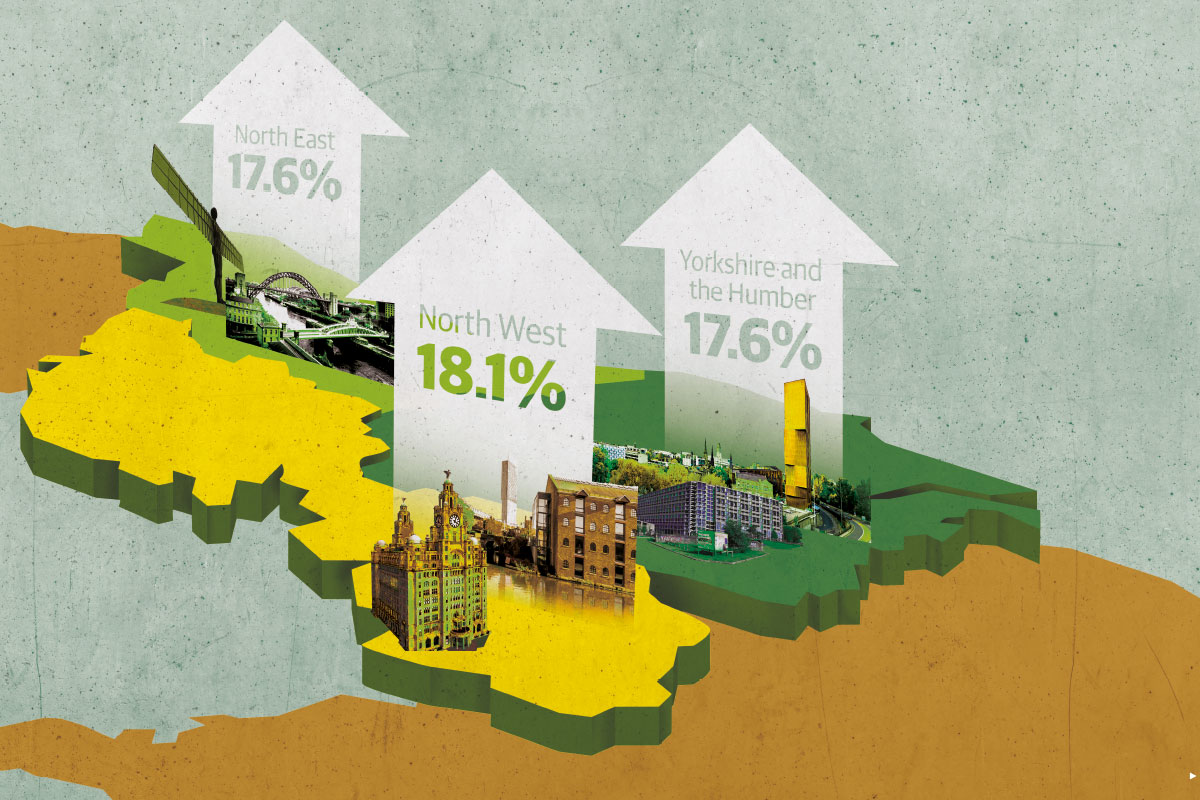You are viewing 1 of your 1 free articles
What do rising house prices in northern England mean for social landlords?
Will surging house prices in the North pose a problem or be a route to growth for social landlords? Steve Sampson finds out how landlords are responding and what it could mean for tenants. Illustration by Alamy, Getty and Jon Heal
Predicted cumulative growth in the North, according to Savills’ five-year forecast
There appears to be a new North-South divide on the way for the housing market.
House prices in parts of the North are surging, while growth is flatlining in London and is much steadier in the South East than it has been for some time.
Manchester saw prices jump 7.2% in the 12 months to April this year, according to the Office for National Statistics. The trend is region-wide, with growth hitting 5.1% in the North West, 4.6% in Yorkshire and the Humber, and 2.8% in the North East, according to estate agent Savills.
That compares with 0% in London and 3.1% in the South East.
With Brexit on the horizon, predictions are fraught with danger. But Savills’ five-year forecast anticipates cumulative growth by 2022 of 18.1% in the North West, 17.6% in Yorkshire and the Humber, 17.6% in the North East, with London at 7.1% and the wider South East at 11.5% (see able below)
In recent years, house price growth has been the source of both problems and a potential route to growth for social landlords. While price growth in the south of the country in particular has led to huge affordability issues, in a world of limited assistance from the government, it has enabled social landlords to cross-subsidise affordable homes from market sale and rent developments.
Obviously, this is not a model that has been confined to the south. But are the changes to the housing market likely to result in social landlords accelerating market sale and private rent programmes in the north of England? And might it even see some landlords that haven’t dabbled much before starting to change their behaviour? Just what is the shape of things to come?
A recent member survey by Homes for the North, an alliance of the region’s 19 largest housing associations, certainly suggests there is likely to be a relatively sizeable proportional shift in what’s delivered. It found that 14% of all housing starts in the region in 2017/18 were for market sale or private rent. But the survey also suggested that portion is likely to increase to 22% of a total of 12,000 planned housing starts to 2021.
Carol Matthews, chief executive of Riverside and chair of Homes for the North, says: “Our research showed that in 2017/18, members had started homes for sale [and] market rent in every city region in the North, with the exception of Hull.
“Looking at the next three years, while unsurprisingly the largest numbers of housing starts will be in the main metropolitan areas, such as Liverpool, Manchester and West Yorkshire, there is planned activity in all regions, with some of the highest proportions of market homes planned in Hull and Tees Valley.”
For Viva Group, which manages more than 24,000 homes across the North West, made the decision to move into the for-sale sector two years ago when cuts to rents loomed and house prices started to edge up.
To do so, it established development arm For Living. Paul Gerrard, its director, says the ambition is not to compete with commercial developers for the sake of it, but harness revenue to drive the provision of affordable homes.
“Everything we make is channelled back into the business. It means not only that we can develop in areas we might not have previously, such as Trafford, but it also means other schemes can now go ahead that might not have got off the ground otherwise.
“We chose Trafford for our first for-sale development because it is our neighbour, so it is convenient to manage. It is a desirable area with great schools [and] healthcare. We hope to start construction in October and deliver in June.”
Of the 58 units being developed, 52 are for sale, two are affordable and four are for shared ownership. With its first market sale development underway, For Living is now eyeing two further developments on its home turf of Salford.
So, what about the risk, particularly with Brexit on the horizon? “There is always a risk, but we appraise each development and stress test plans in scenarios where prices fall. Should that happen, our approach would be to change the properties to different tenure[s],” says Mr Gerrard.
The prospect of self-funding through development is set to underpin a five-year new homes programme at Weaver Vale Housing Trust in Cheshire, where prices have risen by 4.1% over 12 months to April, according to the Office for National Statistics.
The landlord owns 6,200 homes in the area and is looking to bring forward at least 500 new build properties with a range of homeownership and rental tenures.
Gareth Rigby, director of property at the trust, says: “Debates around house price stagnation in the South with values rising rapidly in the North would have been hard to comprehend 12 months ago.
“It shows that you need to build flexibility into pipelines to give landlords the best chance of adapting to fluctuating market conditions.
“Cross-subsidy will be important to us, but we are very clear on our core purpose. Profits will be used to deliver genuinely affordable rental properties. We operate in areas traditionally associated with high property and land values, but there are also pockets where deprivation is a major issue.”
The metropolitan hot spots only tell one side of a complex story. There are many areas where house prices still haven’t recovered from the subprime crisis which started in 2007. Although values are beginning to rise, they are doing so very slowly and from a low starting point.
According to Hometrack’s UK Cities House Price Index published in June, in Burnley house prices rose by 7.1% in the year to April, but are still down 14% on their peak before the crash. In Wakefield they are up 4% in the year but down 4% on 2007, and in Hull prices are up 3.9% to April but 2% down on their boom peak.
Geraldine Howley, chief executive at Incommunities in West Yorkshire, which provides affordable homes to 22,600 households, says the diverse housing markets across the North leads to many different approaches being taken. Incommunities’ geographic footprint covers Bradford, Kirklees, Wakefield and Rotherham.
The key to meeting housing need, while at the same taking the opportunity offered by rising house prices, Ms Howley says, is knowing the market and remaining focused on your social purpose.
“It’s about getting a fix on the market, so you get [the] right type of property, the right tenure, in the right location,” she states. “We’re about regeneration, not gentrification, so any development has to help us meet certain housing criteria.”
Ms Howley compares the Bradford housing market to a doughnut in terms of prices, at their lowest in the centre and rising in the rim of surrounding areas.
At its most extreme, the conundrum posed by rising house prices in such a diverse area is this: a three-bedroom terraced house in good condition costs around £80,000 in inner Bradford, says Ms Howley, but just 12.5 miles away in Ilkley, property values are likely four times that figure.
On one hand, in inner Bradford, at today’s house prices, there would be little demand for a market sale or a even a shared ownership development, and as a revenue-generator such a project would do little more than break even.
“We’re about regeneration, not gentrification, so any development has to help us meet certain housing criteria" Geraldine Howley
On the other hand, any development in a high-value area, such as Ilkley, would inevitably reap revenues, but would need to help Incommunities to fulfil its purpose in providing social housing in that area.
Incommunities’ first for-sale development completed in 2013 in Ben Rhydding and included a tenure-blind mix of market sale and social housing, and was built on a brownfield site that once hosted garages.
Going forward, Ms Howley is keen to stress that the cross-subsidy model would work in many areas in Bradford’s doughnut rim, and more locations would become viable should house prices continue to rise.
But, as mentioned, there are reasons to proceed carefully. Ms Matthews says social landlords need to be relatively cautious, and not become over-reliant on increasing values in areas where scheme viability can still be fairly marginal.
Recent media attention, such as Channel 4’s Dispatches programme that criticised housing associations for moving away from their social purpose, potentially raises another important issue for providers. It underlined the need for social landlords to make sure they tell a compelling story, secure local political support and emphasise the social purpose that market activity helps to fulfil, Ms Matthews suggests.
“Market activity is a ‘means to an end’ in achieving social outcomes,” she adds. And wherever you work in the country, that’s something that should connect all social landlords.
Northern Social Housing Finance Conference
A unique one day-conference for finance professionals, which showcases the latest thinking and best practice in strategy and technical financial management across Northern England
Social Housing and The Northern Housing Consortium are bringing together their collective expertise and insight to launch a new conference which will explore the nuances, challenges and opportunities for housing markets across Northern England.
Taking place at the Crowne Plaza Hotel, Manchester on Thursday 27 September 2018, the conference will explore the latest thinking and best practice around strategic and technical financial management
The conference will cover a wide range of themes including: regeneration, land availability, attracting investment, managing the effects of welfare reform, diversification, opportunities for rural housing, smaller associations, efficiencies, funding and investment outlook.











